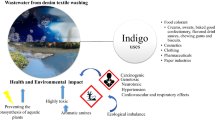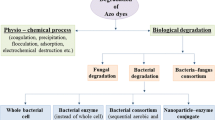Abstract
Removal of Eriochrome Black T (EBT) dye by using cheap and abundant Al2O3 nanoparticles surface was investigated in this work. Weight of Al2O3 nanoparticles, pH and temperature influence on EBT dye removal was optimized by central composite design coupled with response surface methodology. The obtained removal percentage was in a good agreement with the predicted removal percentage. The minimizing error functions (SAE, χ2, ERRSQ, MPSD and HYBRID) and high value of R2 were used to find the optimum isotherm model. Based on error functions among two isotherm models enumerated, the Langmuir isotherm model’s experimental data gave the present study a better depiction.





Similar content being viewed by others
References
Abbas RF, Hami HK, Mahdi NI (2019) Removal of doxycycline hyclate by adsorption onto cobalt oxide at three different temperatures: isotherm, thermodynamic and error analysis. Int J Environ Sci Technol 10:5439–5446
Agarwal M, Patel D, Dinker A (2016) Optimization of manganese removal from water using response surface methodology. Iran J Sci Technol Trans A Sci 40:63–73
Aguila DM, Ligaray MV (2015) Adsorption of eriochrome black T on MnO2-coated zeolite. Int J Environ Sci Dev 6:824
Ahmaruzzaman M, Ahmed MJ, Begum S (2015) Remediation of Eriochrome Black T-contaminated aqueous solutions utilizing H3PO4-modified berry leaves as a non-conventional adsorbent. Desalin Water Treat 56:1507–1519
Ajitha Rani R, Patil MG, Gupta MA (2018) Adsorption of Eriochrme Black T on fly ash: simple and reliable method. Int J Res Anal Rev 5:605–611
Ali MM, Ahmed MJ (2017) Adsorption behavior of doxycycline antibiotic on NaY zeolite from wheat (Triticum aestivum) straws ash. J Taiwan Inst Chem Eng 81:218–224
Aly-Eldeen MA, El-Sayed AA, Salem DM, El Zokm GM (2018) The uptake of Eriochrome Black T dye from aqueous solutions utilizing waste activated sludge: adsorption process optimization using factorial design. Egypt J Aquat Res 44:179–186
Asfaram A, Ghaedi M, Agarwal S, Inderjeet Tyagi I, Gupta VK (2015) Removal of basic dye Auramine-O by ZnS: Cu nanoparticles loaded on activated carbon: optimization of parameters using response surface methodology with central composite design. RSC Adv 5:18438–18450
Banerjee S, Dubey S, Gautam RK, Chattopadhyaya MC, Sharma YC (2019) Adsorption characteristics of alumina nanoparticles for the removal of hazardous dye, Orange G from aqueous solutions. Arab J Chem 12:5339–5535
Bedoui A, Ahmadi MF, Bensalah N, Gadri A (2009) Comparative study of Eriochrome black T treatment by BDD-anodic oxidation and Fenton process. Chem Eng J 146:98–104
Boudouaia N, Bengharez B, Jellali S (2019) Preparation and characterization of chitosan extracted from shrimp shells waste and chitosan film: application for Eriochrome black T removal from aqueous solutions. Appl Water Sci 9:91
Boudrahem F, Ziani S, Aissani-Benissad F (2019) Application of response surface methodology based on central composite design for optimization of yellow bezacryl sorption on shoe soles waste. Environ Prog Sustain Energy 38:S412–S421
Chiban M, Soudani A, Fouad Sinan F, Persin M (2011) Single, binary and multi-component adsorption of some anions and heavy metals on environmentally friendly Carpobrotus edulis plant. Colloids Surf B 82:267–276
Chowdhury S, Misra R, Kushwaha P, Das P (2011) Optimum sorption isotherm by linear and nonlinear methods for safranin onto alkali-treated rice husk. Bioremediat J 15:77–89
Dave PN, Kaur S, Khosla E (2011) Removal of Eriochrome black-T by adsorption on to eucalyptus bark using green technology. Indian J Chem Technol 18:53–60
De Luna MD, Flores ED, Genuino DA, Futalan CM, Wan MW (2013) Adsorption of Eriochrome Black T (EBT) dye using activated carbon prepared from waste rice hulls—optimization, isotherm and kinetic studies. J Taiwan Inst Chem Eng 44:646–653
Dehghani MH, Pourshabanian M, Heidarinejad Z (2018) Experimental data on the adsorption of Reactive Red 198 from aqueous solution using Fe3O4 nanoparticles: Optimization by response surface methodology with central composite design. Data Brief 19:2126–2132
Delil AD, Gülçiçek O, Gören N (2019) Optimization of adsorption for the removal of cadmium from aqueous solution using Turkish coffee grounds. Int J Environ Res 13:861–878
Demirbas E, Kobya MK, Konukman AE (2008) Error analysis of equilibrium studies for the almond shell activated carbon adsorption of Cr(VI) from aqueous solutions. J Hazard Mater 154:787–794
Dhawale VP, Khobragade VB, Kulkarni SD (2018) Synthesis and characterization of aluminium oxide (Al2O3) nanoparticles and its application in azo dye decolourisation. Int J Environ Chem 2:10–17
Ebrahimia M, Mobasherpour I, Bafrooei HB, Bidabadi FS, Mansoorianfar M, Oroojia Y, Khataeed A, Meia C, Salahi E, Ebadzadeh T (2019) Taguchi design for optimization of structural and mechanical properties of hydroxyapatite-alumina-titanium nanocomposite. Ceram Int 45:10097–10105
Garba ZN, Bello I, Galadima A, Lawal AY (2016) Optimization of adsorption conditions using central composite design for the removal of copper (II) and lead (II) by defatted papaya seed. Karbala Int J Mod Sci. 2:20–28
Gengec E, Ozdemir U, Ozbay B, Ozbay I, Veli S (2013) Optimizing dye adsorption onto a waste-derived (modified charcoal ash) adsorbent using Box–Behnken and central composite design procedures. Water Air Soil Pollut 224:1751
Haffad H, Zbair M, Anfar Z, Ahsaine HA, Bouhlal H, Khallok H (2019) Removal of reactive red-198 dye using chitosan as an adsorbent: optimization by Central composite design coupled with response surface methodology. Toxin Rev 38:1–13
Hami HK, Abbas RF, Abed MA, Maryoosh AA (2019) Kinetics study of Removal Doxycycline drug from aqueous solution using Aluminum Oxide surface. Egypt J Chem 62:1713–1723
Hassani A, Kiransan M, Soltani RD, Khataee A, Karaca S (2015a) Optimization of the adsorption of a textile dye onto nanoclay using a central composite design. Turk J Chem 39:734–749
Hassani A, Soltani RDC, Karaca S, Khataee A (2015b) Preparation of montmorillonite–alginate nanobiocomposite for 3 adsorption of a textile dye in aqueous phase: isotherm, kinetic and experimental design approaches. J Ind Eng Chem 21:1197–1207
Hassanzadeh E, Farhadian M, Razmjou A, Askari N (2017) An efficient wastewater treatment approach for a realwoolen textile industry using a chemical assisted NFmembrane process. Environ Nanotechnol Monit Manag 8:92–96
Karri RR, Sahu JN, Jayakumar NS (2017) Optimal isotherm parameters for phenol adsorption from aqueous solutions onto coconut shell based activated carbon: error analysis of linear and non-linear methods. J Taiwan Inst Chem Eng 80:472–487
Khalid A, Zubair M (2018) A comparative study on the adsorption of Eriochrome Black T dye from aqueous solution on graphene and acid-modified graphene. Arab J Sci Eng 43:2167–2179
Khataee AR, Fathinia M, Aber S, Zarei M (2010) Optimization of photocatalytic treatment of dye solution on supported TiO2 nanoparticles by central composite design: intermediates identification. J Hazard Mater 181:886–897
Mudzielwana R, Gitari MW, Ndungu P (2019) Performance evaluation of surfactant modified kaolin clay in As (III) and As (V) adsorption from groundwater: adsorption kinetics, isotherms and thermodynamics. Heliyon 5(11):e02756
Nekouei F, Kargarzadeh H, Nekouei S, Keshtpour F, Makhlouf AH (2017) Efficientmethod for determination ofmethylene blue dye in water samples based on a combined dispersive solid phase and cloud point extraction using Cu(OH)2 nanoflakes: central composite design optimization. Anal Bioanal Chem 409:1079–1092
Postai DL, Demarchi CA, Zanatta F, Melo DC, Rodrigues CA (2016) Adsorption of rhodamineB and methylene blue dyes using waste of seeds of Aleurites Moluccana, a low cost adsorbent. Alex Eng J 55:1713–1723
Pucarevic M, Stojic N, Kuzmanovski I (2017) Removal of pesticides from water using zeolites. Kuwait J Sci 44:99–105
Rostamian R, Behnejad H (2018) Insights into doxycycline adsorption onto graphene nanosheet: a combined quantum mechanics, thermodynamics, and kinetic study. Environ Sci Pollut Res 25:2528–2537
Safa Y (2014) Biosorption of Eriochrome Black T and Astrazon FGGL blue using almond and cotton seed oil cake biomass in a batch mode. J Chem Soc Pak 36:614–623
Sharma SU, Chaturvedi NI, Chaturvedi RK, Sharma MK (2010) Photocatalytic degradation of eriochrome black T using ammonium phosphomolybdate semiconductor. Int J Chem Sci 8:1580–1590
Sisi AJ, Khataee A, Fathinia M, Vahid B (2020) Ultrasonic-assisted degradation of a triarylmethane dye using combined peroxydisulfate and MOF-2 catalyst: synergistic effect and role of oxidative species. J Mol Liq 297:111838
Sivarajasekar N, Mohanraj N, Sivamani S, PrakashMaran J, GaneshMoorthy I, Balasubramani K (2018) Statistical optimization studies on adsorption of ibuprofen onto Albizialebbeck seed pods activated carbon prepared using microwave irradiation. Mater Today Proc. 5:7264–7274
Vaiano V, Matarangolo M, Sacco O, Sannino D (2017) Photocatalytic Removal of Eriochrome Black T dye over ZnO nanoparticles doped with Pr, Ce or Eu. Chem Eng Trans 57:625–630
Yagub MT, Sen TK, Afroze S, Ang HM (2014) Dye and its removal from aqueous solution by adsorption: a review. Adv Coll Interface Sci 209:172–184
Acknowledgements
We thank university of Mustansiriyah, College of Science, Department of Chemistry for helpful about doing this work.
Author information
Authors and Affiliations
Corresponding author
Rights and permissions
About this article
Cite this article
Abbas, R.F., Hami, H.K., Mahdi, N.I. et al. Removal of Eriochrome Black T Dye by Using Al2O3 Nanoparticles: Central Composite Design, Isotherm and Error Analysis. Iran J Sci Technol Trans Sci 44, 993–1000 (2020). https://doi.org/10.1007/s40995-020-00911-6
Received:
Accepted:
Published:
Issue Date:
DOI: https://doi.org/10.1007/s40995-020-00911-6




